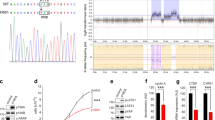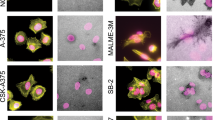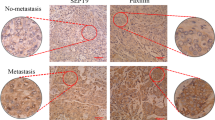Abstract
Loss of E-cadherin-mediated cell–cell junctions has been correlated with cancer cell invasion and poor patient survival. p120-catenin has emerged as a key player in promoting E-cadherin stability and adherens junction integrity and has been proposed as a potential invasion suppressor by preventing release of cells from the constraints imposed by cadherin-mediated cell–cell adhesion. However, it has been proposed that tyrosine phosphorylation of p120 may contribute to cadherin-dependent junction disassembly during invasion. Here, we use small interfering RNA (siRNA) in A431 cells to show that knockdown of p120 promotes two-dimensional migration of cells. In contrast, p120 knockdown impairs epidermal growth factor-induced A431 invasion into three-dimensional matrix gels or in organotypic culture, whereas re-expression of siRNA-resistant p120, or a p120 isoform that cannot be phosphorylated on tyrosine, restores the collective mode of invasion employed by A431 cells in vitro. Thus, p120 promotes A431 cell invasion in a phosphorylation-independent manner. We show that the collective invasion of A431 cells depends on the presence of cadherin-mediated (P- and E-cadherin) cell–cell contacts, which are lost in cells where p120 expression is knocked down. Furthermore, membranous p120 is maintained in invasive squamous cell carcinomas in tumours suggesting that p120 may be important for the collective invasion of tumours cells in vivo.
This is a preview of subscription content, access via your institution
Access options
Subscribe to this journal
Receive 50 print issues and online access
$259.00 per year
only $5.18 per issue
Buy this article
- Purchase on Springer Link
- Instant access to full article PDF
Prices may be subject to local taxes which are calculated during checkout








Similar content being viewed by others
References
Anastasiadis PZ, Reynolds AB . (2000). The p120 catenin family: complex roles in adhesion, signaling and cancer. J Cell Sci 113 (Part 8): 1319–1334.
Aono S, Nakagawa S, Reynolds AB, Takeichi M . (1999). p120(ctn) acts as an inhibitory regulator of cadherin function in colon carcinoma cells. J Cell Biol 145: 551–562.
Ardern H, Sandilands E, Machesky LM, Timpson P, Frame MC, Brunton VG . (2006). Src-dependent phosphorylation of Scar1 promotes its association with the Arp2/3 complex. Cell Motil Cytoskeleton 63: 6–13.
Avizienyte E, Wyke AW, Jones RJ, McLean GW, Westhoff MA, Brunton VG et al. (2002). Src-induced de-regulation of E-cadherin in colon cancer cells requires integrin signalling. Nat Cell Biol 4: 632–638.
Bellovin DI, Bates RC, Muzikansky A, Rimm DL, Mercurio AM . (2005). Altered localization of p120 catenin during epithelial to mesenchymal transition of colon carcinoma is prognostic for aggressive disease. Cancer Res 65: 10938–10945.
Brunton VG, Avizienyte E, Fincham VJ, Serrels B, Metcalf III CA, Sawyer TK et al. (2005). Identification of Src-specific phosphorylation site on focal adhesion kinase: dissection of the role of Src SH2 and catalytic functions and their consequences for tumor cell behavior. Cancer Res 65: 1335–1342.
Brunton VG, MacPherson IR, Frame MC . (2004). Cell adhesion receptors, tyrosine kinases and actin modulators: a complex three-way circuitry. Biochim Biophys Acta 1692: 121–144.
Cozzolino M, Stagni V, Spinardi L, Campioni N, Fiorentini C, Salvati E et al. (2003). p120 Catenin is required for growth factor-dependent cell motility and scattering in epithelial cells. Mol Biol Cell 14: 1964–1977.
Daniel JM, Reynolds AB . (1999). The catenin p120(ctn) interacts with Kaiso, a novel BTB/POZ domain zinc finger transcription factor. Mol Cell Biol 19: 3614–3623.
Davis MA, Ireton RC, Reynolds AB . (2003). A core function for p120-catenin in cadherin turnover. J Cell Biol 163: 525–534.
Davis MA, Reynolds AB . (2006). Blocked acinar development, E-cadherin reduction, and intraepithelial neoplasia upon ablation of p120-catenin in the mouse salivary gland. Dev Cell 10: 21–31.
Friedl P, Hegerfeldt Y, Tusch M . (2004). Collective cell migration in morphogenesis and cancer. Int J Dev Biol 48: 441–449.
Grosheva I, Shtutman M, Elbaum M, Bershadsky AD . (2001). p120 catenin affects cell motility via modulation of activity of Rho-family GTPases: a link between cell–cell contact formation and regulation of cell locomotion. J Cell Sci 114: 695–707.
Hajra KM, Fearon ER . (2002). Cadherin and catenin alterations in human cancer. Genes Chromosomes Cancer 34: 255–268.
Hanahan D, Weinberg RA . (2000). The hallmarks of cancer. Cell 100: 57–70.
Hazan RB, Phillips GR, Qiao RF, Norton L, Aaronson SA . (2000). Exogenous expression of N-cadherin in breast cancer cells induces cell migration, invasion, and metastasis. J Cell Biol 148: 779–790.
Ireton RC, Davis MA, van Hengel J, Mariner DJ, Barnes K, Thoreson MA et al. (2002). A novel role for p120 catenin in E-cadherin function. J Cell Biol 159: 465–476.
Ishizaki Y, Omori Y, Momiyama M, Nishikawa Y, Tokairin T, Manabe M et al. (2004). Reduced expression and aberrant localization of p120catenin in human squamous cell carcinoma of the skin. J Dermatol Sci 34: 99–108.
Islam S, Carey TE, Wolf GT, Wheelock MJ, Johnson KR . (1996). Expression of N-cadherin by human squamous carcinoma cells induces a scattered fibroblastic phenotype with disrupted cell–cell adhesion. J Cell Biol 135: 1643–1654.
Jensen PJ, Telegan B, Lavker RM, Wheelock MJ . (1997). E-cadherin and P-cadherin have partially redundant roles in human epidermal stratification. Cell Tissue Res 288: 307–316.
Keirsebilck A, Bonne S, Staes K, van Hengel J, Nollet F, Reynolds A et al. (1998). Molecular cloning of the human p120ctn catenin gene (CTNND1): expression of multiple alternatively spliced isoforms. Genomics 50: 129–146.
Kelly KF, Spring CM, Otchere AA, Daniel JM . (2004). NLS-dependent nuclear localization of p120ctn is necessary to relieve Kaiso-mediated transcriptional repression. J Cell Sci 117: 2675–2686.
Kurokawa K, Itoh RE, Yoshizaki H, Nakamura YO, Matsuda M . (2004). Coactivation of Rac1 and Cdc42 at lamellipodia and membrane ruffles induced by epidermal growth factor. Mol Biol Cell 15: 1003–1010.
Lim YP, Diong LS, Qi R, Druker BJ, Epstein RJ . (2003). Phosphoproteomic fingerprinting of epidermal growth factor signaling and anticancer drug action in human tumor cells. Mol Cancer Ther 2: 1369–1377.
Malliri A, Symons M, Hennigan RF, Hurlstone AF, Lamb RF, Wheeler T et al. (1998). The transcription factor AP-1 is required for EGF-induced activation of rho-like GTPases, cytoskeletal rearrangements, motility, and in vitro invasion of A431 cells. J Cell Biol 143: 1087–1099.
Mareel M, Leroy A . (2003). Clinical, cellular, and molecular aspects of cancer invasion. Physiol Rev 83: 337–376.
Mariner DJ, Anastasiadis P, Keilhack H, Bohmer FD, Wang J, Reynolds AB . (2001). Identification of Src phosphorylation sites in the catenin p120ctn. J Biol Chem 276: 28006–28013.
Mariner DJ, Davis MA, Reynolds AB . (2004). EGFR signaling to p120-catenin through phosphorylation at Y228. J Cell Sci 117: 1339–1350.
McLean GW, Owsianka AM, Subak-Sharpe JH, Marsden HS . (1991). Generation of anti-peptide and anti-protein sera. Effect of peptide presentation on immunogenicity. J Immunol Methods 137: 149–157.
Noren NK, Liu BP, Burridge K, Kreft B . (2000). p120 catenin regulates the actin cytoskeleton via Rho family GTPases. J Cell Biol 150: 567–580.
Ozawa M, Ohkubo T . (2001). Tyrosine phosphorylation of p120(ctn) in v-Src transfected L cells depends on its association with E-cadherin and reduces adhesion activity. J Cell Sci 114: 503–512.
Park JI, Kim SW, Lyons JP, Ji H, Nguyen TT, Cho K et al. (2005). Kaiso/p120-catenin and TCF/beta-catenin complexes coordinately regulate canonical Wnt gene targets. Dev Cell 8: 843–854.
Peifer M, Polakis P . (2000). Wnt signaling in oncogenesis and embryogenesis – a look outside the nucleus. Science 287: 1606–1609.
Perez-Moreno M, Davis MA, Wong E, Pasolli HA, Reynolds AB, Fuchs E . (2006). p120-catenin mediates inflammatory responses in the skin. Cell 124: 631–644.
Perl AK, Wilgenbus P, Dahl U, Semb H, Christofori G . (1998). A causal role for E-cadherin in the transition from adenoma to carcinoma. Nature 392: 190–193.
Plumb JA, Milroy R, Kaye SB . (1989). Effects of the pH dependence of 3-(4,5-dimethylthiazol-2-yl)-2,5-diphenyl-tetrazolium bromide-formazan absorption on chemosensitivity determined by a novel tetrazolium-based assay. Cancer Res 49: 4435–4440.
Qian X, Karpova T, Sheppard AM, McNally J, Lowy DR . (2004). E-cadherin-mediated adhesion inhibits ligand-dependent activation of diverse receptor tyrosine kinases. EMBO J 23: 1739–1748.
Sahai E . (2005). Mechanisms of cancer cell invasion. Curr Opin Genet Dev 15: 87–96.
Scott LA, Vass JK, Parkinson EK, Gillespie DA, Winnie JN, Ozanne BW . (2004). Invasion of normal human fibroblasts induced by v-Fos is independent of proliferation, immortalization, and the tumor suppressors p16INK4a and p53. Mol Cell Biol 24: 1540–1559.
Shibata T, Kokubu A, Sekine S, Kanai Y, Hirohashi S . (2004). Cytoplasmic p120ctn regulates the invasive phenotypes of E-cadherin-deficient breast cancer. Am J Pathol 164: 2269–2278.
Spring CM, Kelly KF, O’Kelly I, Graham M, Crawford HC, Daniel JM . (2005). The catenin p120ctn inhibits Kaiso-mediated transcriptional repression of the beta-catenin/TCF target gene matrilysin. Exp Cell Res 305: 253–265.
Strathdee G . (2002). Epigenetic versus genetic alterations in the inactivation of E-cadherin. Semin Cancer Biol 12: 373–379.
Thelemann A, Petti F, Griffin G, Iwata K, Hunt T, Settinari T et al. (2005). Phosphotyrosine signaling networks in epidermal growth factor receptor overexpressing squamous carcinoma cells. Mol Cell Proteomics 4: 356–376.
Thoreson MA, Reynolds AB . (2002). Altered expression of the catenin p120 in human cancer: implications for tumor progression. Differentiation 70: 583–589.
van Hengel J, Vanhoenacker P, Staes K, van Roy F . (1999). Nuclear localization of the p120(ctn) Armadillo-like catenin is counteracted by a nuclear export signal and by E-cadherin expression. Proc Natl Acad Sci USA 96: 7980–7985.
van Roy FM, McCrea PD . (2005). A role for Kaiso-p120ctn complexes in cancer? Nat Rev Cancer 5: 956–964.
Vleminckx K, Vakaet Jr L, Mareel M, Fiers W, van Roy F . (1991). Genetic manipulation of E-cadherin expression by epithelial tumor cells reveals an invasion suppressor role. Cell 66: 107–119.
Wheelock MJ, Johnson KR . (2003). Cadherin-mediated cellular signaling. Curr Opin Cell Biol 15: 509–514.
Xia X, Mariner DJ, Reynolds AB . (2003). Adhesion-associated and PKC-modulated changes in serine/threonine phosphorylation of p120-catenin. Biochemistry 42: 9195–9204.
Xiao K, Allison DF, Buckley KM, Kottke MD, Vincent PA, Faundez V et al. (2003). Cellular levels of p120 catenin function as a set point for cadherin expression levels in microvascular endothelial cells. J Cell Biol 163: 535–545.
Yanagisawa M, Anastasiadis PZ . (2006). p120 catenin is essential for mesenchymal cadherin-mediated regulation of cell motility and invasiveness. J Cell Biol 174: 1087–1096.
Author information
Authors and Affiliations
Corresponding author
Additional information
Supplementary Information accompanies the paper on the Oncogene website (http://www.nature.com/onc).
Supplementary information
Rights and permissions
About this article
Cite this article
Macpherson, I., Hooper, S., Serrels, A. et al. p120-catenin is required for the collective invasion of squamous cell carcinoma cells via a phosphorylation-independent mechanism. Oncogene 26, 5214–5228 (2007). https://doi.org/10.1038/sj.onc.1210334
Received:
Revised:
Accepted:
Published:
Issue Date:
DOI: https://doi.org/10.1038/sj.onc.1210334
Keywords
This article is cited by
-
The interferon-β/STAT1 axis drives the collective invasion of skin squamous cell carcinoma with sealed intercellular spaces
Oncogenesis (2022)
-
Snail-induced claudin-11 prompts collective migration for tumour progression
Nature Cell Biology (2019)
-
Every step of the way: integrins in cancer progression and metastasis
Nature Reviews Cancer (2018)
-
TGF-β isoforms induce EMT independent migration of ovarian cancer cells
Cancer Cell International (2014)
-
Fibroblast-led collective invasion of carcinoma cells with differing roles for RhoGTPases in leading and following cells
Nature Cell Biology (2007)



